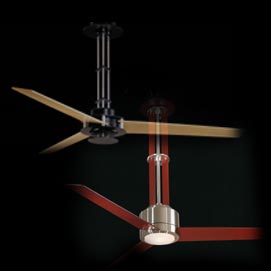How well your ceiling fan performs and
how much energy it will help you save depend a great deal on proper installation
and use. Here are some tips offered by the US EPA to help get the most out
of your appliance.
Read and understand the manufacturer's instructions before attempting to install a ceiling fan.
Be sure to use the appropriate UL-listed metal box, marked
"For Use With Ceiling Fans." This outlet box is mounted above
the ceiling and also is the point where the fan is attached. It houses
all wiring needed to operate and connect the ceiling fan. If you are
replacing a ceiling fixture, you will most likely need to replace the
electrical box.
Anchor the ceiling fan to a ceiling joist if possible. In the case that the joist isn't located in the center of the room,
a special ceiling fan mounting bracket with spiked ends should be installed
between joists. Keep in mind that ceiling fans can weigh as much as
50 pounds! For tips on installing a ceiling fan, click on the file below.
All fan blades should be balanced prior to shipment; however,
if the fan is wobbly after installation, there are ways to fix it. First,
make sure that all connections are properly aligned and tightly fastened.
Check the alignment of the blades by holding a yardstick vertically
along the edges; you may be able to gently bend a misaligned blade holder
back into proper place. If all blades are aligned, a balancing kit can
then be used to pinpoint the culprit. These kits are either provided
within product packaging (e.g., balancing clips and blade weights) or
can be sent by the manufacturer free of charge. View a video with tips
on fixing a wobbly fan.
Turn off when not in the room. Ceiling fans cool
people, not rooms. If the room is unoccupied, turn off the ceiling fan
to save energy.
In the summer, use the ceiling fan in the counter-clockwise
direction. The airflow produced by the ceiling fan creates
a wind-chill effect, making you "feel" cooler.
In the winter, reverse the motor and operate the ceiling fan
at low speed in the clockwise direction. This produces a gentle
updraft, which forces warm air near the ceiling down into the occupied
space.
Remember to adjust your thermostat when using your ceiling
fan for additional energy and dollar savings.


